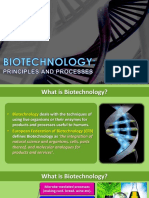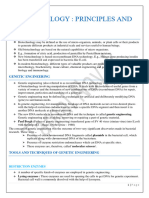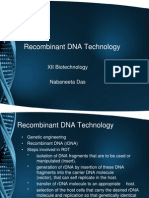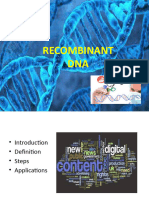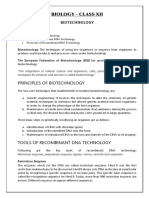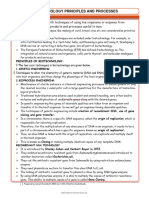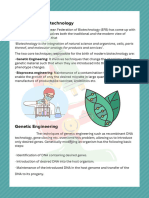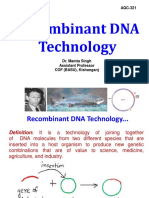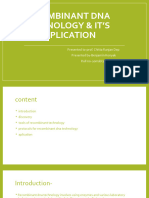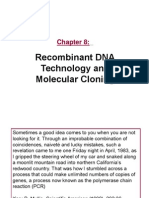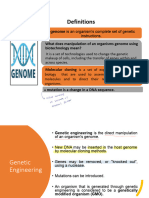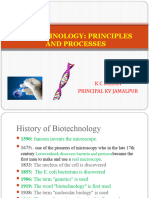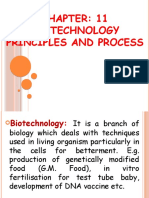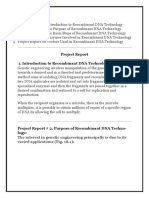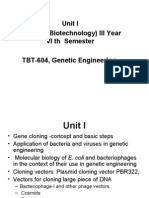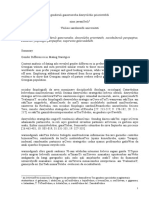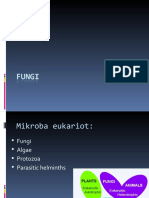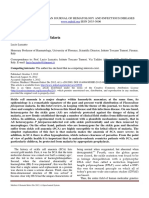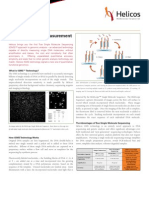Xii Chapter 09 Biotech. P & P
Xii Chapter 09 Biotech. P & P
Uploaded by
sudikshasahoo145Copyright:
Available Formats
Xii Chapter 09 Biotech. P & P
Xii Chapter 09 Biotech. P & P
Uploaded by
sudikshasahoo145Original Title
Copyright
Available Formats
Share this document
Did you find this document useful?
Is this content inappropriate?
Copyright:
Available Formats
Xii Chapter 09 Biotech. P & P
Xii Chapter 09 Biotech. P & P
Uploaded by
sudikshasahoo145Copyright:
Available Formats
DELHI PUBLIC SCHOOL, KALINGA.
CHAPTER-09/BIOTECHNOLOGY: PRINCIPLES AND PROCESSES
• Two core techniques that enabled birth of modern biotechnology:
o Genetic engineering: Techniques to alter the chemistry of genetic material (DNA and
RNA) to introduce into host organisms and thus change the phenotype of the host
organism.
o Maintenance of sterile (microbial contamination-free) ambient chemical engineering
processes to enable growth of only the desired microbe/eukaryotic cell in large quantities.
Conceptual development of the principle of genetic engineering:
• Asexual reproduction preserves the genetic identity of species.
• Sexual reproduction creates variation and creates unique combinations of genetic makeup.
• Traditional hybridization procedures used in plant and animal breeding lead to inclusion
of undesirable genes along with desired genes.
• The techniques of genetic engineering which includes creation of recombinant DNA, use of gene
cloning and gene transfer, overcome this limitation and allows us to isolate and introduce only
one or a set of desirable genes without introducing undesirable genes into target organism.
Construction of the first artificial r DNA molecule:
• In 1972, Stanley Cohen and Herbert Boyer constructed the first recombinant DNA.
• Herbert Boyer worked on restriction enzymes of E. coli which cut DNA in particular fashion and
produce sticky ends on both the strands. These restricted ends were ligated with desired pieces of
DNA.
• Stanley Cohen studied plasmid DNA floating freely in cytoplasm of bacterial cells. He also
developed a method of removing plasmids from the cell and reinserting them in other cells.
• They isolated antibiotic resistant gene from plasmid of bacteria and then linked the gene with
plasmid and incorporated into E coli, where it could replicate using the new host's DNA
polymerase enzyme and make multiple copies.
• Steps carried out in constructing first recombinant DNA:
➢ A gene encoding antibiotic resistance in the native plasmid of Salmonella typhimurium V. was
identified. Plasmid is an autonomously replicating circular extra-chromosomal DNA.
➢ The desired DNA was cut at specific locations by restriction enzymes.
➢ The cut DNA was linked to plasmid DNA and transferred to E. coli for gene multiplication.
• Three basic steps in genetically modifying an organism –
o Identification of DNA with desirable gene
o Introduction of the identified DNA into the host.
o Maintenance of introduced DNA in the host and transfer of the DNA to its progeny.
TOOLS OF RECOMBINANT DNA TECHNOLOGY:
Restriction Enzymes:
• In the year 1963 two enzymes discovered from Escherichia coli ,which restrict the growth of
bacteriophage in it.
o One of these added methyl groups to DNA.
o Other cut the phage DNA. (restriction endonuclease)
• The first restriction endonuclease discovered is Hind II,was isolated by Smith
• Hind II always cut DNA molecule at particular point by recognizing a specific sequence of six
base pairs. This is called recognition sequence for Hind II.
• Till date around 900 restriction enzymes isolated from 200 strains of bacteria each of which
recognize different recognition sequences.
• Restriction enzyme belongs to nucleases.
• There are two kind of nucleases:
o Exonuclease
o Endonuclease
1 Prepared by:Sanjay kumar Jena & V B Rao
DELHI PUBLIC SCHOOL, KALINGA.
• Exonuclease removes nucleotides from the free ends of the DNA.
• Endonucleases make cuts at specific positions within the DNA.
• Each restriction endonuclease recognizes a specific palindromic nucleotide sequences in the
DNA.
• Palindromes are the group of letters that read same both forward and backward, e.g.
“MALAYALAM”.
• The palindrome in DNA is a sequence of base pairs that reads same on the two strands when
orientation of reading is kept same.
• The restriction enzyme cut the strand of DNA little away from the centre of the palindrome sites,
but between the same two bases on the opposite strand. This leaves single stranded portions at the
ends. There are overhanging stretches called sticky ends on each strand.
• This stickiness of the ends facilitates the action of the enzyme DNA ligases.
• The foreign DNA and the host DNA cut by the same restriction endonuclease, the resultant DNA
fragments have the same kind of ‘sticky-ends’ and these can be joined together using DNA ligases.
Convention for naming restriction endonuclease:
• The first letter of the name comes from the genus.
• Second two letters come from the species of the prokaryotic cell from which the enzyme isolated
• The fourth letter is in capital form derived from the Strain of microbes.
• The Roman letter followed is the order of discovery
• Best example: EcoRI comes from Escherichia coli RY 13
Separation and isolation of DNA fragments:
• The cutting of DNA by restriction endonucleases results in the fragments of DNA.
• These fragments are separated by a technique called gel electrophoresis.
• Since the DNA fragments are negatively charged, they can be separated by forcing them to move
towards anode under an electric field through a medium/matrix.
• Most commonly used matrix is agarose, a natural polymer extracted from sea weed.
• DNA fragments separate according to their size through sieving effect provided by the agarose gel.
Hence the smaller the fragment size, farther it moves.
• The separated fragments are visualized by staining them with Ethidium bromide followed by
exposure to UV radiation.
• The separated bands of DNA are cut out from the agarose gel and extracted from the gel piece.
This step is called elution.
Cloning vectors: (Vehicle DNA or carrier of DNA)
• The vectors are the DNA molecules that can carry a foreign DNA segment into the host cell.
Vectors may be:
(a) Plasmids: These are autonomously replicating circular extra-chromosomal DNA.
2 Prepared by:Sanjay kumar Jena & V B Rao
DELHI PUBLIC SCHOOL, KALINGA.
(b) Bacteriophages: These are viruses that infect bacteria. Bacteriophages because of their
high number per cell have very high copy number within bacterial cells.
• Copy number: It is defined as the number of copies of vectors present in a cell. It varies from
1-100 copies per cell.
• Vectors may be plasmids, a bacteriophages (viruses that attack bacteria), cosmids. Yeast
artificial chromosomes (YACS), Bacterial artificial chromosomes (BACs) and viruses. There
are also some shuttle vectors. Out of these vectors, the most commonly used cloning vectors
are plasmids and viruses.
• PBR322 is the first artificial cloning vector developed in 1977 by Boliver and Rodriguez
from E. coli plasmid.
• pBR322 Vector
➢ This was the first artificial cloning vector constructed in 1977 by Boliver and
Rodriguez. It is widely used in gene cloning experiments.
➢ Nomenclature: In PBR 322 plasmid
❖ P-denotes that it is a plasmid;
❖ BR - stands for Boliver and Rodriguez who constructed this plasmid;
❖ 322- is a number given to distinguish this plasmid from others developed in
the same laboratory. For example, there are plasmids PBR 325, PBR 327,
PBR 328, PBR 345 etc.
FEATURES OF CLONING VECTOR:
Origin of replication:
• This is the sequence where the replication starts called ori gene.
• The alien DNA linked with vector also replicates.
• Controls the copy number of the linked DNA.
Selectable marker:
• It is required to identify recombinant from the non-recombinant.
• Helps in identifying and eliminating non-transformants and selectively permitting the growth of
the transformants.
• Transformation is a procedure through which a piece of foreign DNA is introduced in a host
bacterium.
• Normally, the gene coding resistance to antibiotics such as ampicillin. Tetracycline,
chloramphenicol or kanamycins etc are considered as useful selectable markers for E.coli.
• The normal E.coli cells do not carry resistance against any of antibiotics.
Cloning sites:
• In order to link the alien DNA, the vector needs to have very few, preferably single, recognition
sites (palindromic site) for the commonly used restriction endonuclease.
• Commonly used vector is pBR322, for E.coli.
• The ligation of foreign DNA is carried out at a restriction site present in one of the two antibiotic
resistance genes.
• If a foreign DNA ligated or inserted at the Bam H I site of tetracycline resistance gene in the
vector pBR322, the recombinant plasmid will lose tetracycline resistance. (insertional inactivation)
• The recombinant can be identified from the non-recombinant in following steps:
o All are grown in ampicillin medium
o One replica of above plate grown in ampicillin medium (control)
o Other replica grown in the medium containing both tetracycline and ampicillin.
o The colonies grow in plate-I but failed to grow in plate-II are identified as recombinants.
3 Prepared by:Sanjay kumar Jena & V B Rao
DELHI PUBLIC SCHOOL, KALINGA.
Alternative selectable marker:
• On the basis of colour production in the presence of chromogenic substrate, the recombinants and
non-recombinants can also be differentiated.
• Here, a recombinant DNA is inserted within the coding sequence of an enzyme p-galactosidase,
which results into inactivation of the enzyme and hence there is no conversion of substrate to
products.
• Hence, the bacterial colonies having, transformed plasmid, shows no colouration while those
without inserted plasmid form blue colour colonies.
• The foreign DNA is introduced within the coding sequence of an enzyme β-galactosidase, which
convert X-Gal (chromatogenic substrate) into Galactose and 5-bromo+4 chloro indigo (blue color)
• The non-recombinant produce enzyme and give blue colored colonies.
• The recombinant unable to produce β-galactosidase and does not produce blue colored colonies
after addition of chromatogenic substrate i.e. X-Gal.
• This inactivation of insertion of foreign DNA called insertional inactivation.
Vectors for cloning genes in plants and animals:
• Agrobacterium tumefaciens, a pathogenic bacterium of several dicot plants.
• This bacterium contains a plasmid called Ti-plasmid.(tumor inducing)
• In natural condition the A.tumifaciens transfer the T-DNA into the plant which transform normal
plant cells into a tumorand direct these tumor cells to produce the chemical required by the
pathogen.
• Retroviruses in animals have the ability to transform normal cells into cancerous cells.
• The dis-armed retroviruses are being used to transfer gene into animals.
• In Ti-plasmid the T-DNA is replaced by the gene of interest, still A.tumifaciens able to transfer the
gene into the plant without causing tumor in plants.
Competent Host (for transformation with recombinant DNA)
• DNA is a hydrophilic molecule; it cannot pass through cell membranes.
• In order to force bacteria to take-up the plasmid, the bacterial cells must first be made ‘competent’
to take up DNA.
• The bacterial cell is treated with divalent cations such as calcium, which increases the efficiency of
DNA up take by the bacteria.
• Recombinant DNA and the bacterial cells are incubated in ice, followed by placing them briefly at
42oC (heat shock) and then putting them back in ice.
• By microinjection the recombinant DNA directly injected into the nucleus of the animal cell.
• Plant cells are bombarded with high velocity micro-particles of gold or tungsten coated with DNA
in a method known as biolistics or gene gun.
• The disarmed pathogen vectors which when allowed infecting the cell transfer the recombinant
DNA into the host.
4 Prepared by:Sanjay kumar Jena & V B Rao
DELHI PUBLIC SCHOOL, KALINGA.
PROCESS OF RECOMBINANT DNA TECHNOLOGY:
• Isolation of DNA ,
• Fragmentation of DNA by restriction endonuclease.
• Isolation of desired DNA fragment by gel electrophoresis.
• Ligation of DNA fragment with a vector by DNA ligase
• Transferring the recombinant DNA into the host
• Culturing the host cells in a medium at large scale in a bioreactor.
• Extraction of desired product by downstream processing.
Isolation of the Genetic material (DNA):
• Bacterial cell wall digested by Lysozyme.
• Plant cell wall is digested by cellulase and pectinase.
• Fungal cell wall is digested by chitinase.
• RNA of the cellular content is digested by ribonuclease.
• Proteins are removed by Proteases.
• Purified DNA ultimately precipitated out after addition of chilled ethanol.
• The precipitated DNA is separated and removed by spooling.
Amplification of Gene of Interest using PCR:
• PCR stands for Polymerase chain reaction:
• Multiple copy of gene of interest can be synthesized in vitro.
• PCR includes following steps:
Denaturation:
• Double stranded DNA made single stranded.
• It is done by heating the DNA at 94oC.
• Each single stranded DNA is called Template strand.
Annealing:
• Two sets of primer (small oligonucleotide chain that are complementary to the DNA at 3’ end of
the DNA template) added to the medium.
• This is done at around 50oC.
Extension:
• Deoxyribonucleotides triphosphates are added in the medium.
• Taq polymerase catalyses the polymerization reaction using nucleotides extending from the
primer towards 5’ end of the template.
• Taq polymerase is a thermostable polymerase isolated from a bacterium called Thermus
aquaticus.
5 Prepared by:Sanjay kumar Jena & V B Rao
DELHI PUBLIC SCHOOL, KALINGA.
It catalyses polymerization reaction at 74oC.
•
Obtaining the Foreign Gene product or Recombinant product:
• The protein encoding gene is expressed in a heterogeneous host is called a recombinant protein.
• The host is cultured in a continuous culture system provided in bioreactor.
• A bioreactor provides optimum growth conditions (temperature, pH, substrate, salts, vitamins,
oxygen)
• Bioreactor covert the raw materials into specific product, specific enzyme.
Downstream processing:
• After biosynthesis inside the bioreactor, the product has to be subjected through a series of
processes before it is ready for marketing.
• The process includes separation and purification, which are collectively referred as downstream
processing.
• The product has to be formulated in suitable preservatives.
• Such formulation has to undergo through clinical trials as in case of drugs.
S.NO RESTRICTION SOURCE ORGANISM RECOGNITION PRODUCT
ENZYME SEQUENCE AND
SITE OF CLEAVAGE
1 Hind III Haemophillus influenzae Rd 5’-A/AGCTT-3’ Sticky end
3’-TCCGA/A-5’
2 Bam H I Bacillus amyloliquefaciens H 5’-G/GATCC-3’ Sticky end
3’-CCTAG/G-5’
3 Sal I Streptomyce albus 5’-G/TCGAC-3’ Sticky end
3’-CAGCT/G-5’
4 Pvu II Proteus vulgaris 5’-CAG/CTG-3’ Blunt end
3’-GTC/GAC-5’
5 Pst I Providencia stuartii 5’-CTGCA/G-3’ Sticky end
3’-G/ACGTC-5’
6 Pvu I Proteus vulgaris 5’-CGAT/CG-3’ Sticky end
3’-GC/TAGC-5’
7 Eco R I Escherichia coli RY 13 5’-G/AATTC-3’ Sticky end
3’-CTTAA/G-5’
8 Cla I Carypphanon latim 5’-AT/CGAT-3’ Sticky end
3’-TAGC/TA-5’
6 Prepared by:Sanjay kumar Jena & V B Rao
You might also like
- Tutorial On Microarray Analysis Using Bioconductor and R (Sample Study)Document2 pagesTutorial On Microarray Analysis Using Bioconductor and R (Sample Study)Coțovanu IulianNo ratings yet
- Unit 1 Biology IAL Past Papers by TopicDocument23 pagesUnit 1 Biology IAL Past Papers by TopicWillie Wong100% (2)
- BiotechnologyDocument6 pagesBiotechnologyRabiya ShaanNo ratings yet
- Biotechnology Principles and ProcessesDocument9 pagesBiotechnology Principles and Processes228 S.Vignesh 10No ratings yet
- Biotechnology - Principles and Processes - PACEDocument16 pagesBiotechnology - Principles and Processes - PACEHemanth Kumar GNo ratings yet
- Notes CH-11 Biotechnology and Its PrinciplesDocument6 pagesNotes CH-11 Biotechnology and Its Principles16739No ratings yet
- Biotechnology Principle and Processes-NotesDocument4 pagesBiotechnology Principle and Processes-NotesRohan MohantyNo ratings yet
- Biotechnology Principles and ProcessesDocument43 pagesBiotechnology Principles and ProcessesAnushka LimbuNo ratings yet
- II ME NRP B SS 27. Biotechnology-Principles and Processes, Biotechnology - ApplicationsDocument8 pagesII ME NRP B SS 27. Biotechnology-Principles and Processes, Biotechnology - ApplicationsAmit RavindhraNo ratings yet
- Genetic EngineeringDocument38 pagesGenetic EngineeringNaila Izzaty KarimahNo ratings yet
- BIOTECHNOLOGYDocument9 pagesBIOTECHNOLOGYtamalbio7No ratings yet
- Principles of BiotechnologyDocument4 pagesPrinciples of BiotechnologyGauri PalikondawarNo ratings yet
- BiotechnologyDocument7 pagesBiotechnologydebasishgiri5566No ratings yet
- Lecture 20.recombinant DNA TechnologyDocument99 pagesLecture 20.recombinant DNA Technologyqanitakhan2002No ratings yet
- Recombinant DNA Technology CompleteDocument36 pagesRecombinant DNA Technology CompleteAchrya KailashNo ratings yet
- Biotechnology-Principles N Processes-NotesDocument4 pagesBiotechnology-Principles N Processes-Notesaswin20snairNo ratings yet
- Chapter 11 - Biotechnology Principles and ProcessesDocument41 pagesChapter 11 - Biotechnology Principles and Processestoxicdrp3No ratings yet
- Recombinant DNA TechnologyDocument56 pagesRecombinant DNA TechnologyAnkita Priyadarshini100% (1)
- 11 Biotechnology-Principles N Processes-NotesDocument4 pages11 Biotechnology-Principles N Processes-NotesDEEPAK S 9ANo ratings yet
- Biotechnology I (Lecture Note)Document8 pagesBiotechnology I (Lecture Note)Pranav ShinojNo ratings yet
- Biotechnology 1634292871772Document106 pagesBiotechnology 1634292871772l082haripriyakotariNo ratings yet
- 4 R DNADocument22 pages4 R DNArustyryan77No ratings yet
- Recombinant DNA Upkj2rDocument33 pagesRecombinant DNA Upkj2rDivino, Ronald B.No ratings yet
- NXR On BB 9 SW AAry F1 TB OqDocument10 pagesNXR On BB 9 SW AAry F1 TB OqDebangshu BoseNo ratings yet
- BiotechDocument5 pagesBiotechkaiaNo ratings yet
- Biotechnology Principles and Processes - NotesDocument8 pagesBiotechnology Principles and Processes - NotesSquad 4 GamingNo ratings yet
- Biology: Board - Cbse Class - Xii Topic - Principles and ProcessesDocument7 pagesBiology: Board - Cbse Class - Xii Topic - Principles and ProcessesAkshat JainNo ratings yet
- Biotechnologyppt 140709083729 Phpapp01Document52 pagesBiotechnologyppt 140709083729 Phpapp01Sourav DasNo ratings yet
- Add A Little Bit of Body TextDocument9 pagesAdd A Little Bit of Body Textaayushparmar361No ratings yet
- Revision Notes On Biotechnology Principles and Processes NEET 2023 - Free PDF DownloadDocument12 pagesRevision Notes On Biotechnology Principles and Processes NEET 2023 - Free PDF Downloadjemox90864No ratings yet
- Recombinant Dna Technology - 1Document40 pagesRecombinant Dna Technology - 1I FNo ratings yet
- Biotechnology NotesDocument18 pagesBiotechnology NotesAmmar ZahidNo ratings yet
- BIOTECHNOLOGY-principles and ProcessesDocument53 pagesBIOTECHNOLOGY-principles and ProcessesColour Copy100% (1)
- Recombinant DNA TechnologyDocument27 pagesRecombinant DNA TechnologyDeepak VermaNo ratings yet
- Lecture 9 - Recombinant DNA Technology & GEDocument72 pagesLecture 9 - Recombinant DNA Technology & GEchaudharydhruvik8384No ratings yet
- Bio ProjectDocument21 pagesBio ProjectabhayNo ratings yet
- Recombinant Dna Technology & It's ApplicationDocument20 pagesRecombinant Dna Technology & It's Applicationiamcold866No ratings yet
- Biotechnology - Principles and ProcessesDocument9 pagesBiotechnology - Principles and ProcessesspandeydisNo ratings yet
- Biotechnology Principles & ProcessesDocument3 pagesBiotechnology Principles & ProcessesKambaska Kumar BeheraNo ratings yet
- Biotect - Unit IiDocument39 pagesBiotect - Unit IiZeta Tuntun GamingNo ratings yet
- CH 08Document101 pagesCH 08dolt2111No ratings yet
- Genetic Engineering: Aliyu, HabibuDocument32 pagesGenetic Engineering: Aliyu, HabibuAkinsanmi TaiwoNo ratings yet
- Chapter 11 SubDocument22 pagesChapter 11 Subshreya sardesaiNo ratings yet
- Chapter-11 BiotechnologyDocument7 pagesChapter-11 BiotechnologyJay RoyNo ratings yet
- Recombinant DNA TechnologyDocument31 pagesRecombinant DNA TechnologyJay DansNo ratings yet
- Bio Project SpecimenDocument16 pagesBio Project SpecimensrivshresthNo ratings yet
- Biotechnology P and PDocument7 pagesBiotechnology P and Ppedonika.tanked1No ratings yet
- Biotechnology - Principles and Processes - Notes - June 2023Document15 pagesBiotechnology - Principles and Processes - Notes - June 2023Tahsinul islamNo ratings yet
- 4.biotechnology - Principle and ProcessesDocument6 pages4.biotechnology - Principle and ProcessesIndrajith MjNo ratings yet
- BiotechnologyDocument31 pagesBiotechnologyJijendarNo ratings yet
- Manipul. of Gene Expression in ProkaryotesDocument34 pagesManipul. of Gene Expression in ProkaryotesLeviathan ValleyNo ratings yet
- Biotechnology Principles and ProcessesDocument29 pagesBiotechnology Principles and ProcessesKhushi JajalNo ratings yet
- Bio TechnologyDocument51 pagesBio Technologylalithadithya85No ratings yet
- Chapter 11 Biotechnology Principle and ProcessDocument50 pagesChapter 11 Biotechnology Principle and ProcessMkisneymar Meymar100% (1)
- Biotechnology Principles and Processes NotesDocument9 pagesBiotechnology Principles and Processes NotessameemNo ratings yet
- Genetic EngineeringDocument454 pagesGenetic Engineeringhunderaeshetu868No ratings yet
- Contents:: Project Report 1. Introduction To Recombinant DNA TechnologyDocument15 pagesContents:: Project Report 1. Introduction To Recombinant DNA TechnologyShivraj GundayyaNo ratings yet
- Genetic Engineering UNIT I ADocument50 pagesGenetic Engineering UNIT I AhimanshubioNo ratings yet
- DNA Techniques I: DNA Cloning Is The Process of Amplification of A Specific DNA Sequence.Document10 pagesDNA Techniques I: DNA Cloning Is The Process of Amplification of A Specific DNA Sequence.saadyehahmmadNo ratings yet
- PHD Course: Topics in (Nano) BiotechnologyDocument34 pagesPHD Course: Topics in (Nano) BiotechnologyShahrukh ZamanNo ratings yet
- The DNA Detective: Unraveling the Mysteries of Our Genetic CodeFrom EverandThe DNA Detective: Unraveling the Mysteries of Our Genetic CodeNo ratings yet
- Receptors Ion ChannelsDocument42 pagesReceptors Ion ChannelsMd. Ahsan-Ul BariNo ratings yet
- 27 June 9am2 l2 ShubhdaDocument21 pages27 June 9am2 l2 ShubhdaEshu JainNo ratings yet
- Mandal 2007Document9 pagesMandal 2007Maria de los Angeles Martinez PerezNo ratings yet
- CC1 Trans ProteinsDocument7 pagesCC1 Trans Proteinschayiezen0301No ratings yet
- 10 Top Biotechnology Innovations 2023-3Document11 pages10 Top Biotechnology Innovations 2023-3Alfa FilhoNo ratings yet
- SyllabusDocument8 pagesSyllabushurainsahar21No ratings yet
- Chapter 17 AnswersDocument15 pagesChapter 17 AnswersBen LucasNo ratings yet
- 1. გენდერ განსხDocument9 pages1. გენდერ განსხთეკლა გაბრავაNo ratings yet
- B.Ilic, DON'T WANT TO BE A MONSTERDocument58 pagesB.Ilic, DON'T WANT TO BE A MONSTERBranilava IlicNo ratings yet
- Molecular BiologyDocument52 pagesMolecular Biologychandu SahaNo ratings yet
- Seminar Pre EclampsiaDocument50 pagesSeminar Pre EclampsiaManan BoobNo ratings yet
- NSABB Final Report Recommendations Evaluation Oversight Proposed Gain of Function Research May 2016Document109 pagesNSABB Final Report Recommendations Evaluation Oversight Proposed Gain of Function Research May 2016Jim Hoft100% (1)
- Factor Vii DeficiencyDocument12 pagesFactor Vii DeficiencyKaren SalazarNo ratings yet
- CBSE Class 10 Science MCQ Chapter 8 How Do Organisms ReproduceDocument6 pagesCBSE Class 10 Science MCQ Chapter 8 How Do Organisms ReproduceAbhishek SoniNo ratings yet
- Spanish Pigeon BreedsDocument15 pagesSpanish Pigeon Breedsks61234No ratings yet
- PIIS0092867424006317Document32 pagesPIIS0092867424006317Ivan PerezNo ratings yet
- Cambridge IGCSE: BIOLOGY 0610/41Document20 pagesCambridge IGCSE: BIOLOGY 0610/41zahraherreeNo ratings yet
- Lab 13: Mendelian Laws and Paterns of InheritanceDocument24 pagesLab 13: Mendelian Laws and Paterns of InheritanceNau MaanNo ratings yet
- Kuliah Jamur Genetika 2014Document22 pagesKuliah Jamur Genetika 2014Maskur Fahmi ÄdibasNo ratings yet
- Module 1 BiochemDocument40 pagesModule 1 BiochemAlyssa PachecoNo ratings yet
- The History and Scope of Microbiology: Dr. Preeti SangaveDocument59 pagesThe History and Scope of Microbiology: Dr. Preeti SangaveKrittika ChatterjeeNo ratings yet
- Sickle Cell Anaemia and Malaria PDFDocument6 pagesSickle Cell Anaemia and Malaria PDFshjahsjanshaNo ratings yet
- Kingdom ProtistDocument43 pagesKingdom ProtistShyra Nicole AllarseNo ratings yet
- Helicos TSMS Technology PrimerDocument2 pagesHelicos TSMS Technology PrimerNhu Phuong NguyenNo ratings yet
- Forensic Chemistry ActivityDocument22 pagesForensic Chemistry ActivityStefanie Puguon Nipahoy100% (1)
- Autoimmunity 2022Document22 pagesAutoimmunity 2022Raphael AnajeNo ratings yet
- Identification and Characterization of Essential Genes in The Human GenomeDocument7 pagesIdentification and Characterization of Essential Genes in The Human Genome戴义宾No ratings yet
- The Concept of Parasite Derived ResistanceDocument11 pagesThe Concept of Parasite Derived Resistanceplanhigion06No ratings yet







